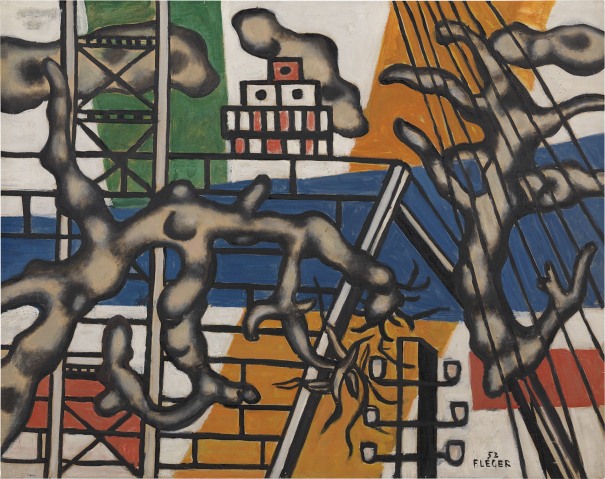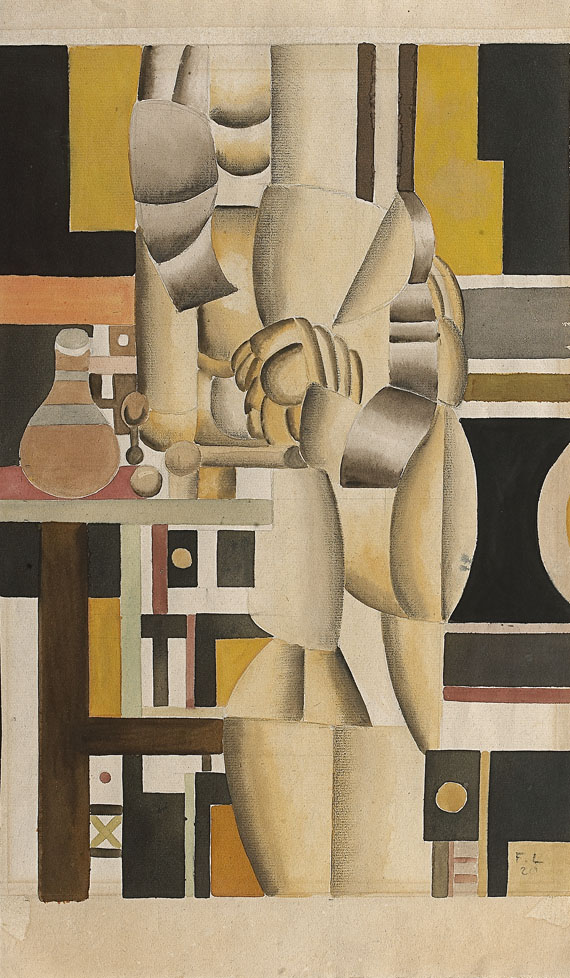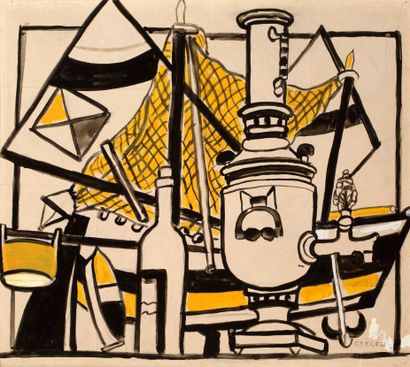Fernand Léger Follow Composition à la fleur signed and dated 'F. Léger. 31' lower right oil on canvas laid on board 46 x 38 cm (18 1/8 x 14 7/8 in.) Painted in 1931.
Provenance Galerie Jean Bucher, Paris Private Collection (acquired from the above circa 1950) Thence by descent to the previous owner Christie's, London, 25 June 2003, lot 198 E & R Cyzer Gallery, London (acquired at the above sale) Private Collection Exhibited London, E & R Cyzer, Thirty Works by Modern Masters , 2004, cat. no. 14, n.p. (illustrated) Literature Georges Bauquier Fernand Léger Catalogue Raisonné de l'Oeuvre Peint 1929-1931. vol. 4 , Paris, 1995, no. 769, p. 276 (illustrated) Catalogue Essay Immersing the viewer in his colourful and mysterious world, Composition à la fleur is an exceptional example, originating from the middle of Fernand Léger’s career. Depicted in an unidentified space, separated from the remainder of the composition, a flower sprouts from a plane of green, serving as the namesake for the masterful work. Consisting of predominantly architectural elements, staircases and arches, and a blanket of amorphous forms, the flower instills a natural aura into the composition. The harmonious colours and forms infuse rhythm and energy into the work, displaying an on-going process of experimentation and discovery by the artist whose concern with movement and colour radiates through his creative output. In 1931, when Léger painted Composition à la fleur , he had already visited the United States of America, where he later settled after escaping World War II. Léger’s creative output during the early 1930s can be considered his most enigmatic, with the artist’s transition of thought and evolution of style clearly evident. Throughout the 1930s Léger began to transform the austerity of the architectural structure of compositions into level, un-modeled surfaces akin to the Surrealist experimentations, juxtaposing irrational space. The present work displays the artist’s exceptional balance of colour, structure and naturally geometric forms, each element carefully studied and selected to build up the fabric of the composition. Despite its careful composition, upon examining Composition à la fleur the viewer becomes conscious of the freedom of the work, each object floating within the plane, emancipated from the constraints of traditional perspective. Abstract and metaphysical, the elements appear distinct from any representational function, individual segments are brought together, their connection seemingly inexplicable and mysterious. Displacing objects from their conventional context, readjusting them to create new relationships, Léger questions our notion of reality within the still life. Expressing an idea based upon the foundation of real objects dispersed out of context, Léger asserted ‘I placed objects in space so that I could take them as a certainty. I felt that I could not place an object on a table without diminishing its value.’ (Dora Vallier, ‘La vie fait l’oeuvre de Fernand Léger Propos receuillis’ Cahiers d’Art , Paris, XXIX, 1954, pp. 152-153.) In Composition à la fleur , the flower becomes central to the viewer’s focus, the enduring motif which first appeared in the 1920s, was further developed in the 1930s and subsequently revisited throughout the artist’s career. A prominent example of what was to come, the present work is a masterful still life in which formal scenic and architectural elements are discarded. Demonstrating the artist’s gradual transition toward organic and irregular forms, the composition radiates with dynamic rhythm; the blocked out areas of primary and secondary colours enhancing the focal point of the work- the flower. Demonstrating Leger’s absolute mastery of configuration, his use of white accents to frame the image emphasizes the structure of the work. Composition à la fleur draws parallels to his early 1914 works, similarly forms were revealed and the composition was lightened through Leger’s skilled usage of paint. Seminal to the path of twentieth century painting, Fernand Léger’s Composition à la fleur is an exquisite example of the artist’s celebrated work, retaini
Fernand Léger Follow Composition à la fleur signed and dated 'F. Léger. 31' lower right oil on canvas laid on board 46 x 38 cm (18 1/8 x 14 7/8 in.) Painted in 1931.
Provenance Galerie Jean Bucher, Paris Private Collection (acquired from the above circa 1950) Thence by descent to the previous owner Christie's, London, 25 June 2003, lot 198 E & R Cyzer Gallery, London (acquired at the above sale) Private Collection Exhibited London, E & R Cyzer, Thirty Works by Modern Masters , 2004, cat. no. 14, n.p. (illustrated) Literature Georges Bauquier Fernand Léger Catalogue Raisonné de l'Oeuvre Peint 1929-1931. vol. 4 , Paris, 1995, no. 769, p. 276 (illustrated) Catalogue Essay Immersing the viewer in his colourful and mysterious world, Composition à la fleur is an exceptional example, originating from the middle of Fernand Léger’s career. Depicted in an unidentified space, separated from the remainder of the composition, a flower sprouts from a plane of green, serving as the namesake for the masterful work. Consisting of predominantly architectural elements, staircases and arches, and a blanket of amorphous forms, the flower instills a natural aura into the composition. The harmonious colours and forms infuse rhythm and energy into the work, displaying an on-going process of experimentation and discovery by the artist whose concern with movement and colour radiates through his creative output. In 1931, when Léger painted Composition à la fleur , he had already visited the United States of America, where he later settled after escaping World War II. Léger’s creative output during the early 1930s can be considered his most enigmatic, with the artist’s transition of thought and evolution of style clearly evident. Throughout the 1930s Léger began to transform the austerity of the architectural structure of compositions into level, un-modeled surfaces akin to the Surrealist experimentations, juxtaposing irrational space. The present work displays the artist’s exceptional balance of colour, structure and naturally geometric forms, each element carefully studied and selected to build up the fabric of the composition. Despite its careful composition, upon examining Composition à la fleur the viewer becomes conscious of the freedom of the work, each object floating within the plane, emancipated from the constraints of traditional perspective. Abstract and metaphysical, the elements appear distinct from any representational function, individual segments are brought together, their connection seemingly inexplicable and mysterious. Displacing objects from their conventional context, readjusting them to create new relationships, Léger questions our notion of reality within the still life. Expressing an idea based upon the foundation of real objects dispersed out of context, Léger asserted ‘I placed objects in space so that I could take them as a certainty. I felt that I could not place an object on a table without diminishing its value.’ (Dora Vallier, ‘La vie fait l’oeuvre de Fernand Léger Propos receuillis’ Cahiers d’Art , Paris, XXIX, 1954, pp. 152-153.) In Composition à la fleur , the flower becomes central to the viewer’s focus, the enduring motif which first appeared in the 1920s, was further developed in the 1930s and subsequently revisited throughout the artist’s career. A prominent example of what was to come, the present work is a masterful still life in which formal scenic and architectural elements are discarded. Demonstrating the artist’s gradual transition toward organic and irregular forms, the composition radiates with dynamic rhythm; the blocked out areas of primary and secondary colours enhancing the focal point of the work- the flower. Demonstrating Leger’s absolute mastery of configuration, his use of white accents to frame the image emphasizes the structure of the work. Composition à la fleur draws parallels to his early 1914 works, similarly forms were revealed and the composition was lightened through Leger’s skilled usage of paint. Seminal to the path of twentieth century painting, Fernand Léger’s Composition à la fleur is an exquisite example of the artist’s celebrated work, retaini



.jpg)






.jpg)
.jpg)


Try LotSearch and its premium features for 7 days - without any costs!
Be notified automatically about new items in upcoming auctions.
Create an alert